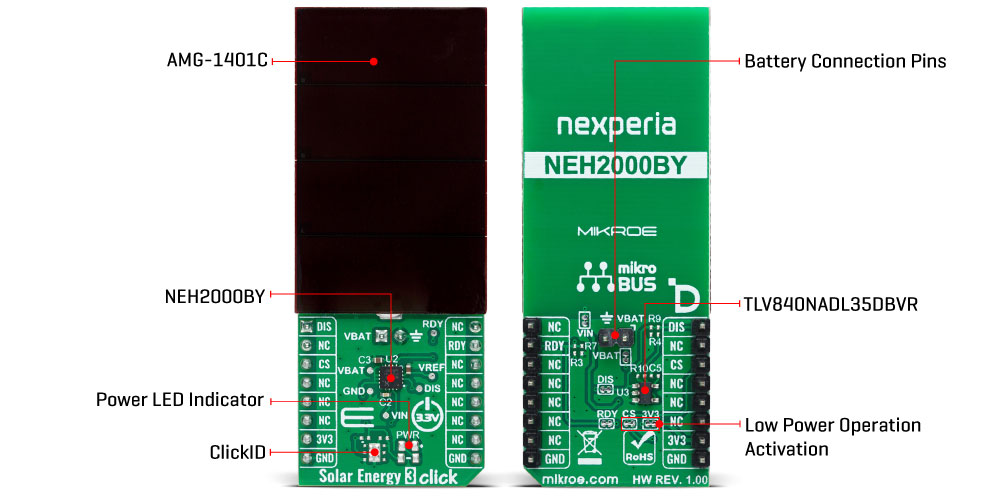OFF
GO LOCAL
| Company | Stock | Price |
|---|---|---|

MIKROE-6057
22 g
Status:
Solar Energy 3 Click - 1V8 is a compact add-on board for energy harvesting in low-power applications. This board features the NEH2000BY, an energy-harvesting PMIC from Nexperia. This board also features the AMG-1401C photovoltaic cell, known for its high efficiency of over 20%, even in low and artificial light environments. The NEH2000BY manages energy harvesting and prevents overcharging the connected rechargeable battery by automatically disabling itself when the battery voltage condition is met. This compact board is ideal for powering IoT devices, sensor nodes, asset trackers, and remote controls, providing a reliable and sustainable power solution in various light conditions.
This product is no longer in stock
Availability date:
OFF
| Company | Stock | Price |
|---|---|---|

Solar Energy 3 Click - 1V8 is based on the NEH2000BY, an energy-harvesting PMIC from Nexperia that harnesses solar energy for low-power applications. The NEH2000BY uses a photovoltaic (PV) cell, specifically the AMG-1401C, assembled on the board. The AMG-1401C is a hydrogenated amorphous silicon solar cell known for its nearly perfect black-reflective surface and larger active area. This high-efficiency solar cell, with an efficiency greater than 20%, is among the most effective indoor amorphous solar cells available. This high-performance energy harvesting solution is designed for 1.8V low-power applications, making it ideal for indoor and outdoor IoT devices, sensor nodes, asset trackers, and remote controls. It efficiently harvests energy even in low light and artificial light environments.

The harvested energy charges a rechargeable battery or supercapacitor connected to the VBAT header (J1) on the board's bottom side. A battery should not be over-charged. Continuing charging, in that case, can damage the battery. An energy harvester, the NEH2000BY, should stop harvesting once the battery is fully charged. This can be implemented by activating the automatic harvest-disable feature by populating the R10 resistor that activates the TLV840NADL35DBVR, which detects when VBAT has reached a voltage of 3.6V. This voltage is a condition for creating a disabled signal to the NEH2000BY. Once the 3.6V VBAT is detected, the TLV840NADL35DBVR turns off the harvester.
For its control, the Solar Energy 3 Click - 1V8 uses only the DIS and RDY pins of the mikroBUS™ socket. The DIS pin is used to deactivate harvesting when the battery is full. The NEH2000BY is active when this pin is in a LOW logic state. When the device's Start-Up sequence is complete, the RDY pin indicates a HIGH logic state. Additionally, the board includes numerous test points for various signals from the NEH2000BY, such as ready and disable signals and VBAT/VREF/VIN voltages, allowing for seamless prototyping and testing.
This Click board™ is designed to serve as a power source for systems like harvestKIT™, an advanced energy harvesting reference design platform that enhances the energy efficiency of various devices. Operating exclusively at a 1.8V logic voltage, it offers flexibility in power management and is intended for powering small consumers, or their batteries up to 3.6V.
Ambiq’s harvestKIT™ is an advanced energy harvesting reference design platform that significantly enhances the energy efficiency of various devices. It empowers developers to create more sustainable and energy-efficient products. By harnessing energy from the environment, it can extend the life of batteries or, in some cases, eliminate the need for them entirely by using supercapacitors and other energy storage elements. This platform is ideal for applications such as smart home and building automation, remote monitoring, video game controllers, wearables, asset trackers, and factory automation. You can find more detailed information and explore how harvestKIT™ can benefit your projects on its product page.
Type
Battery charger,Solar Charger
Applications
Ideal for powering IoT devices, sensor nodes, asset trackers, and remote controls, providing a reliable and sustainable power solution in various light conditions
On-board modules
NEH2000BY - energy-harvesting PMIC from Nexperia
Key Features
Energy-harvesting PMIC combined with the AMG-1401C solar cell, solar cell with 20% efficiency in low and artificial light conditions, automatically disables charging to prevent overcharging, disable pin for deactivating energy harvesting when the battery is full, ready signal, low power operation, numerous test points, and more
Interface
GPIO
Feature
ClickID
Compatibility
mikroBUS™
Click board size
L (57.15 x 25.4 mm)
Input Voltage
1.8V,3.3V
This table shows how the pinout on Solar Energy 3 Click - 1V8 corresponds to the pinout on the mikroBUS™ socket (the latter shown in the two middle columns).
| Label | Name | Default | Description |
|---|---|---|---|
| LD1 | PWR | - | Power LED Indicator |
| JP1-JP2 | 3V3-CS | Connected | Low Power Consumption Usage Activation |
| JP3 | VBAT | Connected | Battery Usage Activation |
| JP4 | DIS | Connected | Harvester Disable Usage Activation |
| JP5 | RDY | Connected | Device Ready Usage Activation |
| Description | Min | Typ | Max | Unit |
|---|---|---|---|---|
| Supply Voltage | 1.8 | - | 3.3 | V |
| Battery Voltage | - | - | 3.6 | V |
This Click board currently comes without dedicated MIKROE mikroSDK support in the form of libraries, functions, or example code.
For Technical support questions, the customers can submit a support case to Nexperia by following the procedure.
NOTE: Please be advised that any peripheral devices or accessories shown connected to the Click board™ are not included in the package. Check their availability in our shop or in the YMAN section below.